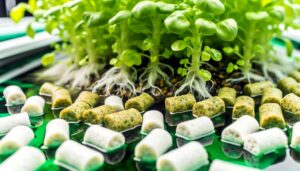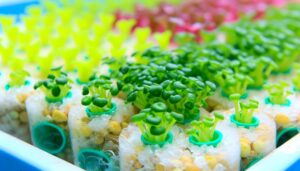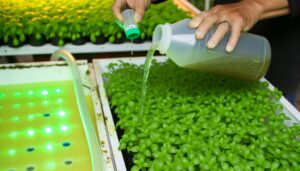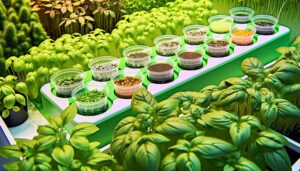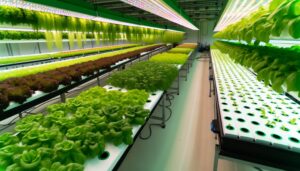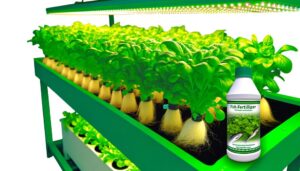How to Use Hydroponic Tray Nms
Utilizing a hydroponic tray in a nutrient management system (NMS) involves several critical steps. Begin by choosing a tray made of durable, non-reactive materials like HDPE or food-grade plastic.
Accurately set up your system, guaranteeing proper drainage and smooth surfaces for ease of maintenance. Maintain nutrient-specific solutions, keeping pH levels between 5.5 and 6.5 and electrical conductivity within 1.2-2.0 mS/cm.
Use high-quality seeds and guarantee adequate light exposure and air circulation for peak growth. Regularly monitor water levels to prevent root rot and other issues.
By managing these factors precisely, you can achieve peak plant growth and system efficiency. Continue exploring for in-depth insights and troubleshooting tips.
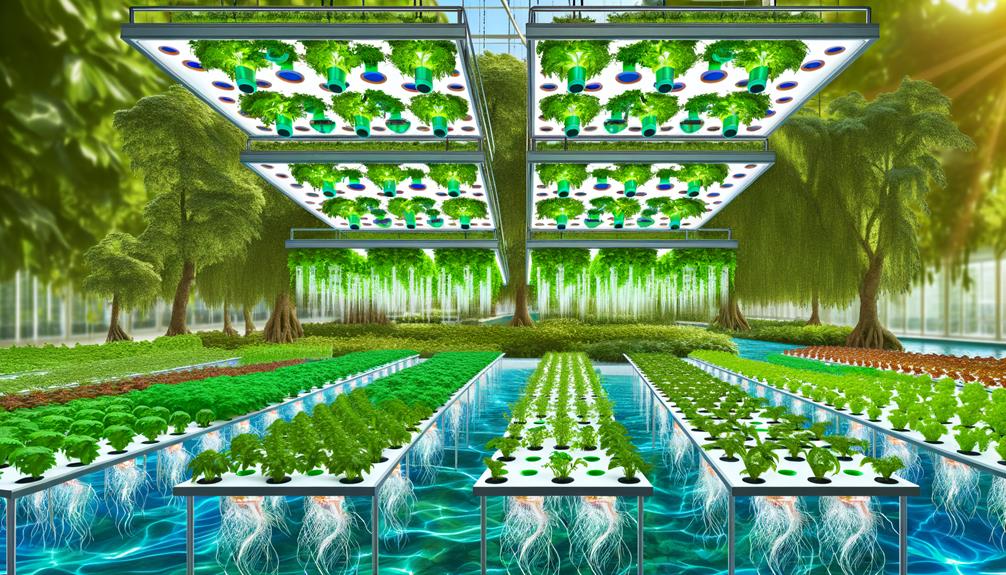
Key Takeaways
- Select durable, non-reactive materials like HDPE or stainless steel for the hydroponic tray.
- Ensure the tray has adequate drainage to prevent waterlogging and root rot.
- Maintain nutrient solution pH between 5.5 and 6.5 and monitor EC levels for optimal plant growth.
- Provide 14-16 hours of light daily using full-spectrum LEDs, adjusting intensity based on plant species.
Choosing the Right Tray
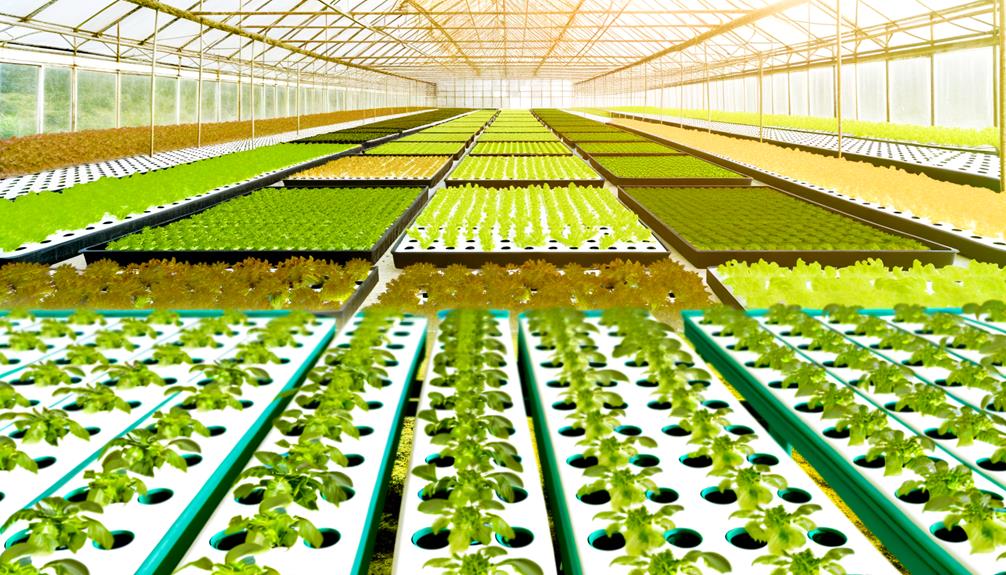
Selecting the appropriate hydroponic tray is fundamental to guarantee ideal growth and efficiency in your hydroponic system.
The tray material must be durable and non-reactive to prevent contamination.
Size considerations include the number of plants and space constraints.
Depth is essential; shallow trays are suitable for small plants, whereas deeper trays accommodate larger root systems.
Ascertain proper drainage to prevent waterlogging and root rot.
Compatibility with other system components, such as grow lights and nutrient delivery systems, is also critical.
Opt for trays with smooth surfaces to facilitate easy cleaning and maintenance.
Additionally, consider trays with built-in channels or grooves for maximal nutrient flow and distribution.
Each of these factors collectively influences plant health and system performance.
Setting Up the System
Setting up the hydroponic system begins with selecting appropriate tray materials, ensuring durability and compatibility with your chosen plants.
Following this, precise preparation of the nutrient solution is critical to deliver essential nutrients directly to the plant roots.
Each step must be executed with accuracy to optimize growth conditions and system efficiency.
Selecting Tray Materials
Choosing the appropriate materials for hydroponic trays is vital to guarantee durability and ideal growth conditions for plants.
High-density polyethylene (HDPE) is a preferred choice due to its robustness and resistance to corrosion, securing longevity. Food-grade plastic is essential to prevent toxic leaching into the nutrient solution.
Consider UV-stabilized plastics if the system is exposed to sunlight, to mitigate degradation. Avoid materials prone to cracking or warping under varying humidity and temperature conditions.
Stainless steel, though more costly, provides unmatched durability and is non-reactive. Confirm the trays have smooth surfaces to facilitate easy cleaning and sanitation.
The selection of appropriate tray materials is a pivotal step in optimizing the hydroponic system's efficiency and sustainability.
Nutrient Solution Preparation
The accurate preparation of the nutrient solution is essential for ensuring ideal plant growth and system efficiency in hydroponic setups. Begin by selecting high-quality, hydroponic-specific nutrients that provide a balanced mix of essential elements. Measure pH and electrical conductivity (EC) levels meticulously, aiming for a pH range of 5.5 to 6.5 and an EC appropriate to the plant species.
| Component | Ideal Range | Notes |
|---|---|---|
| pH | 5.5 – 6.5 | Essential for nutrient uptake |
| Electrical Conductivity (EC) | 1.2 – 2.5 mS/cm | Varies with plant type |
| Nitrogen (N) | 150-200 ppm | Promotes leaf growth |
| Phosphorus (P) | 50-70 ppm | Critical for root development |
Regularly monitor and adjust the nutrient solution to maintain these parameters, ensuring ideal growth conditions.
Selecting Nutrient Solutions
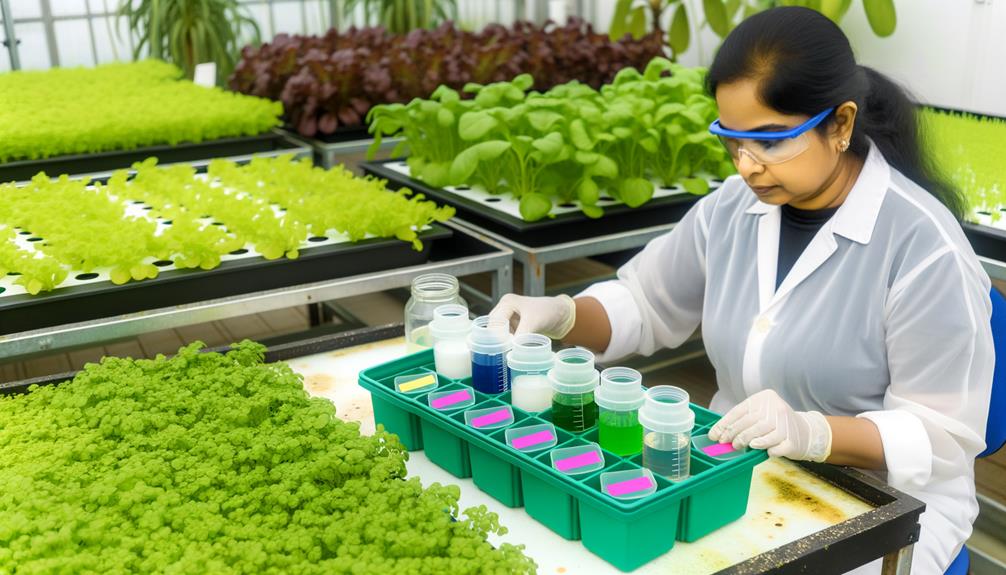
Selecting the appropriate nutrient solution is critical for optimizing plant growth and health in a hydroponic system. A well-chosen nutrient solution supplies the essential macro and micronutrients required for robust plant development.
Factors to take into account in selecting nutrient solutions include:
- Nutrient Composition: Confirm the solution contains all essential elements such as nitrogen, phosphorus, potassium, calcium, magnesium, and trace elements.
- pH Stability: Choose solutions that maintain stable pH levels, typically between 5.5 and 6.5.
- Solubility: Opt for highly soluble formulations to prevent clogging and confirm uniform nutrient distribution.
- Compatibility: Verify compatibility with your hydroponic system and plant species.
Carefully evaluating these factors will enhance the effectiveness of your hydroponic gardening.
Planting Your Seeds
Planting seeds in a hydroponic tray requires careful selection of high-quality seeds, a thorough understanding of the germination process, and precise control of growing conditions.
Ensuring these factors are maximized will greatly impact plant health and yield.
This section will provide detailed guidance on selecting appropriate seeds, initiating germination, and maintaining ideal environmental conditions for hydroponic growth.
Seed Selection Tips
Carefully choosing high-quality seeds is essential for the success of your hydroponic system. To maximize growth and yield, it is important to select seeds that are well-suited for hydroponic cultivation.
Consider the following tips when selecting seeds:
- Type of Plant: Opt for plants known to thrive in hydroponic systems, such as leafy greens, herbs, and certain fruiting plants.
- Seed Quality: Use seeds from reputable suppliers to guarantee genetic purity and liveliness.
- Germination Rate: Look for seeds with a high germination rate to guarantee a robust start.
- Disease Resistance: Choose seeds bred for resistance to common pests and diseases.
These criteria will help guarantee a productive and efficient hydroponic setup.
Germination Process Overview
Initiating the germination process is a critical step in guaranteeing the successful cultivation of plants in your hydroponic system.
Begin by selecting a high-quality growth medium, such as rockwool or coco coir, which provides ideal support and moisture retention for seedlings.
Pre-soak the growth medium in pH-balanced water to create an ideal environment for seed germination.
Carefully place each seed into the medium, guaranteeing proper spacing to prevent overcrowding.
Maintain consistent moisture levels by lightly misting the medium with water.
It is essential to provide adequate air circulation and maintain a temperature range of 68-77°F (20-25°C) to facilitate germination.
Monitoring and adjusting these parameters will guarantee robust seedling development, laying the foundation for a thriving hydroponic system.
Optimal Growing Conditions
Establishing ideal growing conditions is essential for maximizing the health and yield of your hydroponic plants. Proper environmental controls guarantee that plants receive the necessary nutrients, light, and temperature for peak growth. During the planting phase, consider the following key factors:
Light Intensity: Guarantee plants receive 14-16 hours of light daily using LED or fluorescent grow lights.
Nutrient Solution: Maintain correct nutrient balance and pH levels (5.5-6.5) in the water.
Temperature: Keep the ambient temperature between 65-75°F (18-24°C) for most crops.
Humidity: Maintain relative humidity between 50-70% to prevent diseases and promote growth.
Air Circulation: Use fans or ventilation systems to guarantee adequate airflow and prevent mold.
Monitoring Water Levels
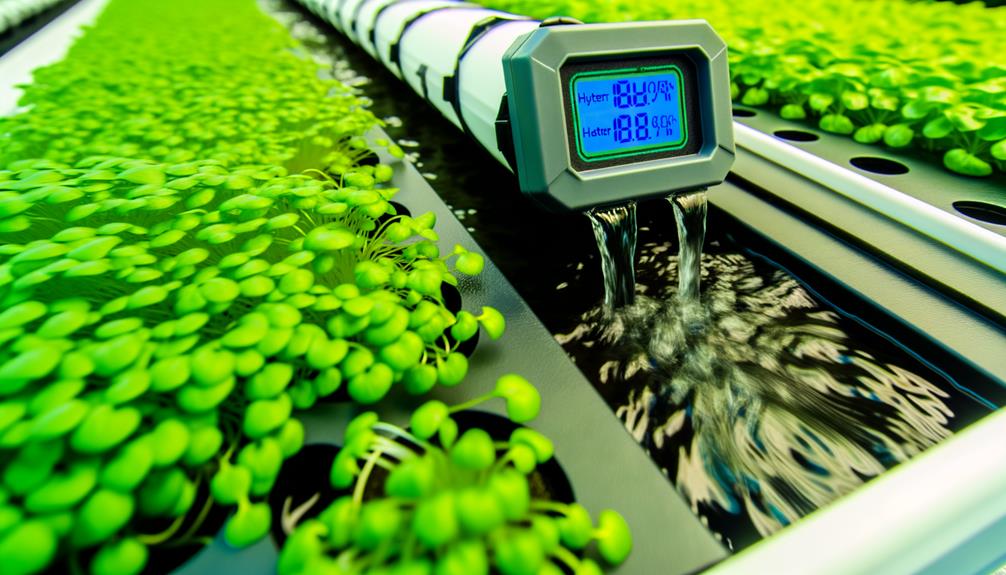
Monitoring water levels is a critical aspect of maintaining a hydroponic system, ensuring that plants receive the ideal amount of nutrients and hydration. Consistently checking and adjusting water levels prevents nutrient imbalances and promotes peak plant growth. Employing automated sensors or manual measurements can help maintain the appropriate water levels. Below is a table outlining key parameters and recommended actions for effective water level management:
| Parameter | Recommended Action |
|---|---|
| Water pH | Adjust to 5.5 – 6.5 |
| Electrical Conductivity (EC) | Maintain 1.2 – 2.0 mS/cm |
| Water Temperature | Keep between 18-24°C |
| Reservoir Refill Frequency | Check and refill daily |
| Sensor Calibration | Calibrate weekly |
Managing Light Exposure
Proper management of light exposure is essential for maximizing photosynthesis and guaranteeing robust plant growth in a hydroponic system.
The correct spectrum, intensity, and duration of light are pivotal in mimicking natural sunlight and promoting healthy development.
- Light Spectrum: Utilize full-spectrum LED lights to replicate natural sunlight.
- Light Intensity: Adjust the light intensity to suit the plant species, generally ranging between 200 to 800 µmol/m²/s.
- Photoperiod: Maintain a consistent light cycle, typically 16-18 hours of light followed by 6-8 hours of darkness.
- Light Distance: Position lights at an appropriate distance from plants, generally 12-24 inches, to prevent light burn.
Implementing these practices guarantees prime conditions for plant growth.
Troubleshooting Common Issues
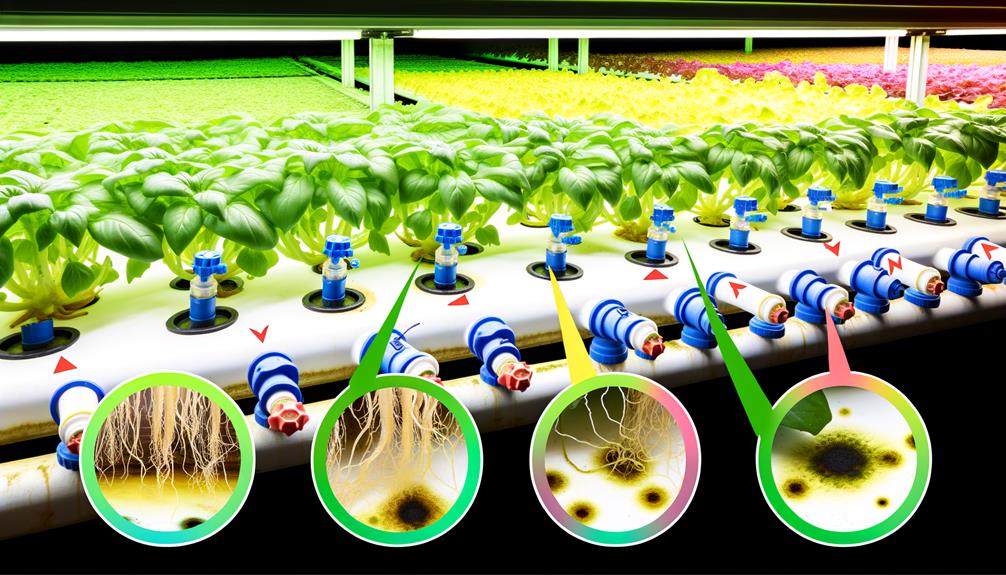
Guaranteeing ideal light exposure is just one aspect of hydroponic success, but even with optimal circumstances, growers may encounter common problems that require troubleshooting.
Root rot, often caused by overwatering or inadequate oxygen supply, can be mitigated by guaranteeing proper aeration and monitoring water levels.
Nutrient deficiencies manifest as yellowing leaves or stunted growth; adjusting nutrient solution concentrations based on plant requirements is essential.
Pests such as aphids or spider mites can be managed through integrated pest management strategies, including biological controls and regular inspections.
pH imbalances can disrupt nutrient absorption; maintaining pH levels between 5.5 and 6.5 typically guarantees ideal circumstances.
Regular monitoring and swift corrective actions are key to maintaining a healthy hydroponic system.
Conclusion
The proficient utilization of hydroponic trays necessitates meticulous selection of appropriate trays, precise system setup, judicious choice of nutrient solutions, and careful planting of seeds.
Ensuring ideal water levels and managing adequate light exposure are imperative for plant health.
Addressing common issues with adept troubleshooting techniques is essential for maintaining system efficacy.
Mastery of these components will facilitate the attainment of an efficient and productive hydroponic cultivation environment, thereby enhancing overall agricultural output. Proper utilization of rapid rooters in hydroponics can further optimize plant growth by providing a stable and nutrient-rich medium for root development. These specialized growing plugs promote faster germination and stronger root structures, ultimately leading to healthier plants. By integrating these components into the system, growers can achieve higher yields and more consistent crop quality.

